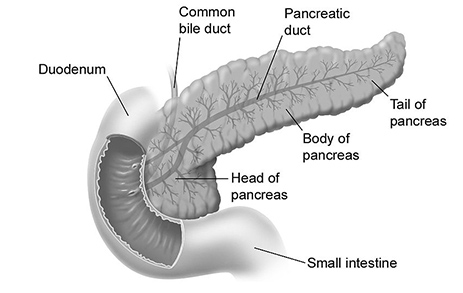The Pancreas
What is The Pancreas?
The pancreas is a glandular organ that is vital for digestion and sugar control. It is located high up in the abdomen and lies across your body, behind your stomach, and in front of the spine. It is about 6 inches long and shaped like a flat pear.
It is composed of three sections:
- the wide end of the pancreas on the right side of the body is called the head;
- the middle section is called the body;
- the thin end on the left side of the body is called the tail.
The pancreas has two very different and important roles: digestive and endocrine functions.
Digestive Functions
The digestive glands of the pancreas produce enzymes that help to break down food. When food enters the stomach, pancreatic exocrine cells release digestive enzymes into a system of ducts, which lead to the main pancreatic duct. The pancreatic duct empties the pancreatic juices containing enzymes and bicarbonate into the first portion of the small intestine called the duodenum. Here, the enzymes aid in the digestion of fats, carbohydrates, and proteins in foods.
Endocrine Functions
The second function of the pancreas is the endocrine function, which involves the production of hormones. The two key hormones produced by the pancreas are insulin and glucagon, which are released into the bloodstream. Together, they regulate the level of glucose (sugar) in your blood. Insulin serves to lower blood sugar levels after a meal while glucagon raises blood sugar levels in between meals.
The Two Types of Pancreatic Cancer
1. Exocrine tumours: Over 95% of all pancreatic tumours are exocrine tumours. The most common type of pancreatic cancer is adenocarcinoma, which begins in the cells that line your organs.
2. Neuroendocrine tumours: Less than 5% of pancreatic tumours are neuroendocrine tumours.
Exocrine Pancreatic Cancer
Exocrine pancreatic cancer develops from exocrine cells, which make up the exocrine gland and ducts of the pancreas. The exocrine gland secretes enzymes that help break down carbohydrates, fats, proteins and acids in the duodenum.
Adenocarcinoma
Also called ductal carcinoma, adenocarcinoma, is the most common type of pancreatic cancer, accounting for more than 90% of pancreatic cancer diagnoses. This cancer occurs in the lining of the ducts in the pancreas. It’s also possible for adenocarcinoma to develop from the cells that create pancreatic enzymes. When this occurs, it is called acinar cell carcinoma, which accounts for 1 to 2% of exocrine cancers.
Squamous Cell Carcinoma
This extremely rare nonendocrine cancer of the pancreas forms in the pancreatic ducts, and is made purely of squamous cells, which are not typically seen in the pancreas.
Adenosquamous Carcinoma
This rare type of pancreatic cancer represents 1 to 4% of exocrine pancreatic cancers. Compared with adenocarcinoma, adenosquamous carcinoma is a more aggressive tumour with a poorer prognosis. These tumours show characteristics of both ductal adenocarcinoma and squamous cell carcinoma.
Colloid Carcinoma
Another rare type, colloid carcinomas account for 1 to 3% of exocrine pancreatic cancers. These tumours tend to develop from a type of benign cyst called an intraductal papillary mucinous neoplasm (IPMN). Because the pancreatic colloid tumour consists of malignant cells that float in a gelatinous substance called mucin, it is not as likely to spread and is easier to treat than other pancreatic cancers.
Neuroendocrine Pancreatic Cancer
Pancreatic neuroendocrine tumours (PNETs) develop from cells in the endocrine gland of the pancreas, which secretes the hormones insulin and glucagon into the bloodstream to regulate blood sugar. Also known as endocrine or islet cell tumours, neuroendocrine cancers are rare, making up less than 5% of all pancreatic cancer cases.
Diagnostic Terminology
- Resectable – This type of pancreatic cancer can be surgically removed. A tumour may lie within the pancreas or extend beyond it, but there is no involvement of the critical arteries or veins in the area. There is no evidence of any spread to areas outside of the pancreas.
- Borderline Resectable – This diagnosis is used when unsure of whether or not a tumour can be removed.
- Unresectable – Locally advanced and unresectable tumours are still confined to the area around the pancreas but cannot be surgically removed because they involve the critical arteries or veins, or the tumour directly extends to surrounding organs. There is no evidence of spread to any distant areas of the body.
- Metastatic – The tumour has spread beyond the area of the pancreas and involves other organs, such as the liver or distant areas of the abdomen.

The Stages of Pancreatic Cancer
Staging describes or classifies a cancer based on how much cancer there is in the body and where it is when first diagnosed. Information from tests is used to find out the size of the tumour, which parts of the organ have cancer, whether the cancer has spread from where it first started and where the cancer has spread.
Stage I
The tumour is 4 cm or smaller. For stage 1A, the tumour is 2 cm or smaller. For stage 1B, the tumour is larger than 2 cm but not larger than 4 cm.
Stage II
The tumour is larger than 4 cm (stage 2A). Or the tumour is any size and the cancer has spread to 1 to 3 nearby lymph nodes (stage 2B).
Stage III
The cancer has spread to 4 or more nearby lymph nodes. Or the tumour has grown into large blood vessels outside of the pancreas and the cancer may have spread to nearby lymph nodes.
Stage IV
The cancer has spread to other parts of the body, such as the liver, lungs or abdominal cavity. This is also called metastatic pancreatic cancer.
Have Questions?
It’s not unusual to have questions after receiving a pancreatic cancer diagnosis. Our Ask An Expert service can help you to make informed decisions about your care between appointments with your doctor.


316-4211 Yonge Street
Toronto, ON M2P 2A9
Toll Free: 1-888-726-2269
info@pancreaticcancercanada.ca
Charitable Registration Number 84870 1967 RR0001

